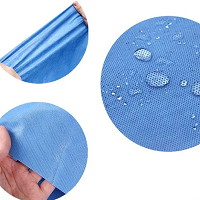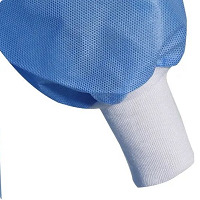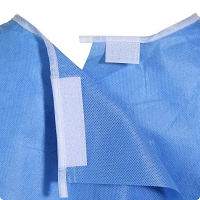Jianda Medical | Jianda Brand Nonwoven Surgical Gowns
Jining Jianda Medical Device Technology
Co., Ltd. produces nonwoven surgical gowns using high-performance three-resistant
(anti-blood, anti-static, anti-alcohol) SMMS nonwoven fabric and wood
pulp spunlace nonwoven fabric as the main materials, tailored to
clinical needs. This fabric offers high-efficiency protection, comfort,
convenience, and eco-friendliness, effectively blocking microorganisms such
as HIV, HBV viruses, and bacteria, controlling nosocomial cross-infections,
reducing postoperative inflammation, and serving as a secure barrier for
sterile areas during surgical procedures.
Eight Advantages of Jianda Surgical
Gowns
- Balanced Protection and Breathability
Sterilized by ethylene oxide (EO), these gowns are breathable, waterproof, and provide excellent fluid resistance and bacterial barrier properties to safeguard medical staff.

- Ultrasonic Welding Technology
The ultrasonic welding process ensures waterproofing, sealing, and antimicrobial functions, effectively blocking liquids while meeting medical-grade standards.
- Adjustable Waist Ties
Customizable waist ties allow for a personalized fit, ensuring comfort and easy donning/doffing.

- Elastic Knitted Cuffs
Knitted elastic cuffs prevent dust and bacteria from entering while enhancing wearing comfort.

- Hook-and-Loop Fasteners
User-friendly hook-and-loop closures streamline operations for medical staff.

- Long Shelf Life
After EO sterilization, nonwoven gowns
maintain sterility for 2–3 years under intact packaging,
compared to cloth gowns, which remain sterile for only 14 days
(winter/spring) or 1 week (summer) after autoclaving.
- Cost-Effective and Eco-Friendly
While nonwoven gowns have higher upfront
costs, cloth gowns incur additional expenses for labor, resources, and
replacements during washing, disinfection, and storage. Cloth gowns also
generate 大量污水 requiring treatment and eventual
incineration, whereas nonwoven gowns reduce water/chemical use and burn
into 95% water vapor and CO₂,
minimizing pollution.
